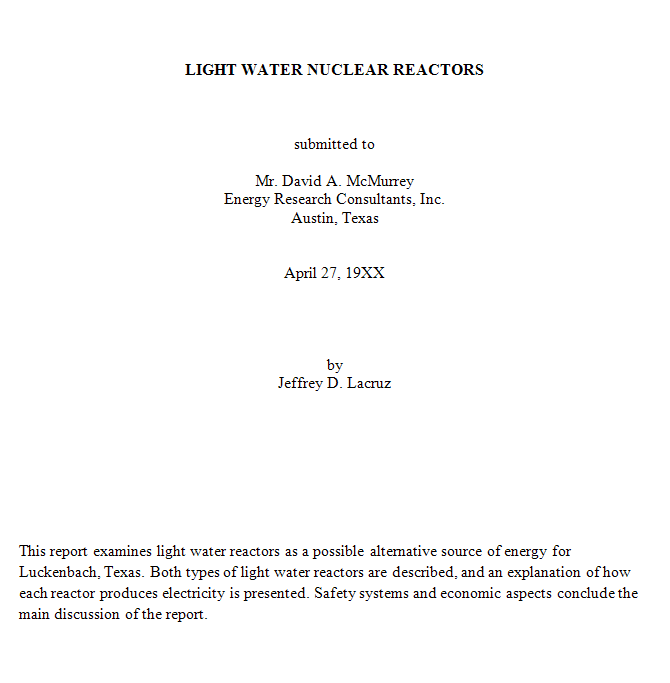6.3: Formal Report—Abstract/Summary
Learning Objectives
- Explore the options for writing a formal report abstract/summary
What Is the Role of an Abstract/Summary?
Most technical reports contain a summary and/or abstract. What is the difference between the two? According to the University of Springfield Centre for Teaching and Learning (n.d.),
The terms summary and abstract are often used interchangeably resulting in some confusion. This problem arises because there are two distinct types of abstracts—descriptive and informative. The descriptive abstract is usually only 2 or 3 sentences in length; hence, it is not a summary or very informative. An informative abstract (summary) is an abbreviated version of the most significant points in a book, article, report or meeting. It is usually about 5% to 15% of the length of the original. It is useful because it condenses material, informing the reader of the most important points.
Type #1: Descriptive Abstract
This type of abstract provides an overview of the purpose and contents of the report. It does not summarize the report contents.
In some report designs, the descriptive abstract is placed at the bottom of the title page, as shown in the following:
Type #2: Informative Abstract or Summary
Another common type of abstract, the informative abstract or summary, condenses the key facts, conclusions, and recommendations contained in the report. Think of this as if you used a yellow highlighter to mark the key sentences in the report and then siphoned them all out onto a separate page and edited them for readability. The summary should include points from each section of the report. The point of the summary is to provide a quick overview of the report that can be read quickly.
Example: Informative Abstract/Summary
A technology platform based on commercial printed circuit boards (PCB) technology is developed and presented. It integrates rigid flame retardant (FR)-4 boards, flexible polyimide (PI) structures, and embedded cavities for micro- and meso-scale applications. The cavities or channels can be filled with fluids for microfluidic and lab-on-chip systems. In this study, an electromagnetic energy harvester with enhanced output was designed and implemented in the platform. To enhance harvester output, the embedded cavities were filled with ferrofluid (FF) to improve the overall magnetic circuit design and electromechanical coupling of the device. The fabricated PCB-based harvester had a dimension of 20 mm × 20 mm × 4 mm. Vibration tests of the harvesters were conducted with different magnet sizes and different FF. Test results showed up to a 70% enhancement of output voltage and a 195% enhancement of output power when the cavities were filled with oil-based FF as compared with harvesters without FF. When the cavities were filled with water-based FF, the enhancement of voltage and power increased to 25% and 50%, respectively.
References & Attributions
References
University of Springfield Centre for Teaching and Learning. (n.d.), Summaries and abstracts. https://www.uis.edu/ctl/wp-content/uploads/sites/76/2013/03/smreabs.pdf
Attributions
Content is adapted from Technical Writing by Allison Gross, Annemarie Hamlin, Billy Merck, Chris Rubio, Jodi Naas, Megan Savage, and Michele DeSilva, which is is licensed under a Creative Commons Attribution-NonCommercial-ShareAlike 4.0 International License, except where otherwise noted.
Original content for this page was derived by Annemarie Hamlin, Chris Rubio, and Michele DeSilva, Central Oregon Community College from Online Technical Writing by David McMurrey – CC: BY 4.0
Example of Abstract/Summary is adapted from Chiu Y., & Hong H-C. (2018). Rigid-flex PCB technology with embedded fluidic cavities and its application in electromagnetic energy Harvesters. Micromachines. 9(6):308. https://doi.org/10.3390/mi9060308, which is licensed under CC BY 4.0.


